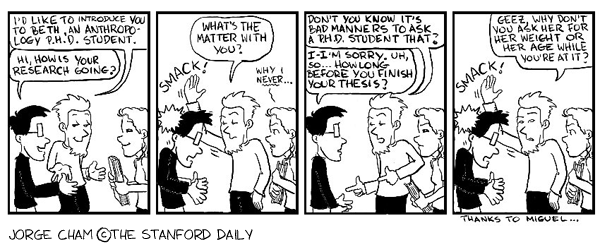Before I started writing my thesis, I made a twitter account for it. I recently downloaded the archive of its tweets to my excessive amusement. I forgot at one point it tweeted in frustration:
@JodiesThesis: Also, if you don't want people to ask about me, STOP TALKING ABOUT ME!!!
I am now one of those people who can ask a PhD student (or Masters student) about their thesis without currently working on a thesis myself. Now that I'm on the other side though, the taboo on asking doesn't seem as obvious as when I was inside.
 |
| This Golden Era* PhD Comic says it all really *Golden Era = before my thesis |
A friend just messaged me that she shared my post on "Rules for talking with a thesis writer" to a group of friends recently after explaining that asking about the thesis was not helpful. She was glad to wake the next day to messages of loving support.
So I thought I'd reflect on how I successfully ask about the thesis now that I am not bound by concurrent suffering.
So I thought I'd reflect on how I successfully ask about the thesis now that I am not bound by concurrent suffering.
1. I ask when I'm available to listen at length
I ask when I'm catching up for coffee, not when I'm chatting on facebook. I ask when I haven't seen them for a while, not when I see them every week.
Consider the analogy of the PhD as a marathon. You may have certain checkpoints where you assess how you're going, whether you're ahead or behind your goal time, whether you need to speed up in the next leg, or pace yourself for the end. You don't want to be asked every 100m how it's going. And that's what it can end up with thesis writers - maybe you don't ask every day, but somebody does. And it gets tedious.
2. I ask when I can encourage without dismissing
I tell them they can do it, but I don't deny their fears. I don't broadly sweep it under a generalised opinion that they're smart so therefore they must be able to do it. There are very smart people who have not finished PhDs. An important part of the thesis is managing the stress, guilt, and pressure, not just sitting down and writing endlessly. As I drew at one point, it feels more like battling a dragon than typing.
At the same time I keep an eye out for Impostor Syndrome. Then I ENCOURAGE WITH CAPSLOCK SO THEY HAVE TO BELIEVE ME!
At the same time I keep an eye out for Impostor Syndrome. Then I ENCOURAGE WITH CAPSLOCK SO THEY HAVE TO BELIEVE ME!
3. I ask after we've talked about other things
The PhD does start to consume you completely and I know in the last month or two before I submitted, I didn't have room in my head to think about other things. My friend and I would be having coffee, talking about other things then zone out and suddenly burst out with an argument we could use in our thesis. We'd nod agreement to each other without really understanding more than vaguely then resume discussing coffee, or annoying people, or the weather, or all the things that will be better once we take over the university.
However here I think the useful analogy is not PhD as a full-time job, but PhD candidate like a stay-at-home parent.
However here I think the useful analogy is not PhD as a full-time job, but PhD candidate like a stay-at-home parent.
 |
| Stay-at-home thesis-writing mum! Image courtesy of Lean In / Getty Images collaboration to provide non-stereotyped stock photos of women |
While they love their child (the thesis), they spend 24 hours a day thinking about it. They have their sympathetic parents group (PG study group/supervision panel/shut up and write crew) to talk to at length about it. And when they go out for coffee with someone from outside that world, it's really really nice to talk about something else for a while. Chances are they'll inevitably draw the conversation back to their Pride And Joy, but that's their choice.
4. I know when not to ask
I don't ask if I know they're approaching an important deadline. I'll spend a whole hour talking about everything but the thesis - I'll ask about work, the family, the house, anything, because I know they don't need me guilt-tripping them into work.
| The white rabbit is the thesis-writer's equivalent of an elephant in the room, if the elephant was screaming "You're late! You're late! For a very important date!" |
5. I ask because I've been there
The exception to the "Don't ask about the thesis" rule is that you can ask if you have first hand experience of writing a thesis.
I don't know exactly why. It's just a fundamental Truth.
However, between you and me, I think that if you take into account everything I've said, you can get away with asking.
I don't know exactly why. It's just a fundamental Truth.
However, between you and me, I think that if you take into account everything I've said, you can get away with asking.





